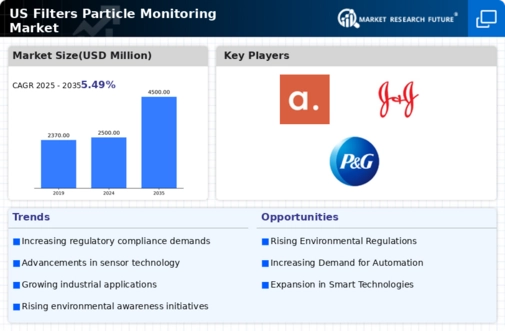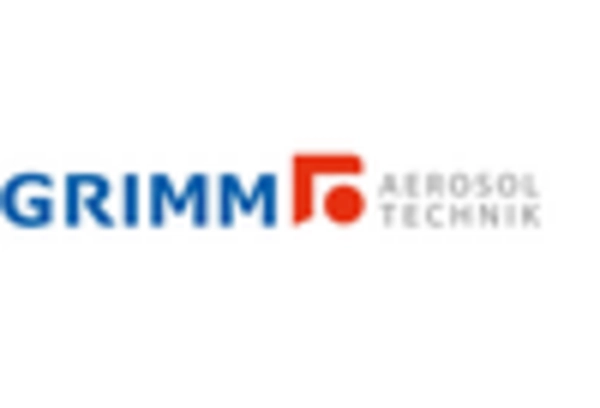Rising Industrial Emissions
The filters particle-monitoring market is significantly influenced by the rising levels of industrial emissions across various sectors. As industries expand, the need for effective monitoring solutions to track particulate emissions becomes increasingly critical. Regulatory agencies are imposing stricter emission standards, compelling industries to adopt advanced monitoring systems to ensure compliance. The filters particle-monitoring market is projected to grow as companies invest in technologies that can accurately measure and report emissions. In 2025, the industrial segment is expected to account for approximately 40% of the total market share. This trend indicates a robust demand for monitoring solutions that can help industries mitigate their environmental impact while adhering to regulatory requirements. The focus on reducing emissions is likely to drive innovation and investment in the filters particle-monitoring market.
Government Initiatives and Funding
Government initiatives aimed at improving air quality and public health are playing a crucial role in the filters particle-monitoring market. Various federal and state programs are being implemented to promote the adoption of air quality monitoring systems. Funding opportunities for research and development in this field are also increasing, which could lead to advancements in monitoring technologies. The filters particle-monitoring market is expected to benefit from these initiatives, as they encourage the development of innovative solutions that meet regulatory standards. In 2025, government funding for air quality monitoring is projected to exceed $500 million, indicating a strong commitment to enhancing public health through improved monitoring. This financial support is likely to drive growth in the market, as it enables companies to invest in new technologies and expand their product offerings.
Increasing Environmental Awareness
The growing concern regarding air quality and environmental health is driving the filters particle-monitoring market. As individuals and organizations become more aware of the detrimental effects of particulate matter on health, there is a rising demand for effective monitoring solutions. This trend is reflected in the increasing investments in air quality monitoring systems, which are projected to reach $4 billion by 2026. The filters particle-monitoring market is likely to benefit from this heightened awareness, as consumers seek reliable data to inform their decisions. Furthermore, regulatory bodies are emphasizing the need for accurate monitoring to ensure compliance with air quality standards, further propelling market growth. The integration of advanced technologies in monitoring systems is also expected to enhance the effectiveness of these solutions, making them more appealing to end-users.
Health Concerns Related to Air Quality
Health concerns associated with poor air quality are a significant driver for the filters particle-monitoring market. Studies have shown that exposure to particulate matter can lead to serious health issues, including respiratory diseases and cardiovascular problems. As public awareness of these health risks increases, there is a growing demand for effective monitoring solutions to assess air quality. The filters particle-monitoring market is likely to see heightened interest from healthcare providers and public health organizations seeking to implement monitoring systems in urban areas. The market is projected to grow as these entities invest in technologies that provide accurate and timely data on air quality. Furthermore, educational campaigns aimed at informing the public about the dangers of air pollution may further stimulate demand for monitoring solutions.
Technological Integration in Monitoring Systems
The filters particle-monitoring market is experiencing a surge in demand due to the integration of advanced technologies in monitoring systems. Innovations such as IoT, AI, and machine learning are enhancing the capabilities of particle monitoring devices, allowing for real-time data collection and analysis. This technological evolution is expected to drive market growth, as organizations seek more efficient and accurate monitoring solutions. The market for smart air quality monitoring systems is anticipated to grow at a CAGR of 12% from 2025 to 2030. As these technologies become more accessible, the filters particle-monitoring market is likely to see increased adoption across various sectors, including industrial, commercial, and residential applications. The ability to provide actionable insights through advanced analytics is also a key factor that could attract more users to these innovative monitoring solutions.

















Leave a Comment